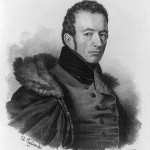S.C. Encyclopedia | Joel Roberts Poinsett was born on March 2, 1779, in Charleston, son of the Huguenot physician Elisha Poinsett and his English wife, Ann Roberts. As a child, Poinsett spent six years in England, where his formal education probably began. In 1794 he entered the Greenfield Hill, Connecticut, academy of Dr. Timothy Dwight but stayed only two years because of his frail health. Returning to England, Poinsett attended private school at Wandsworth, where he excelled in languages. In 1797 he began medical school in Edinburgh, Scotland, but remained only one year. Returning to Charleston, Poinsett briefly studied law in 1800, but his interest quickly waned. In 1801 Poinsett set out for Europe, where he would spend most of the next seven years traveling across the continent. His fluency in foreign languages helped him form associations with several powerful European leaders, including Napoleon I, the French financier Jacques Necker, and Czar Alexander I of Russia.

Poinsett
Poinsett returned home in 1808 as war between Britain and the United States loomed. He hoped to secure a military appointment but instead in 1810 was named U.S. trade envoy to South America, where British forces regarded him as a “suspicious character.” An ardent republican who long wanted a military career, Poinsett was soon promoting rebellion among South American countries. Failing to persuade Buenos Aires to break with Spain, in 1811 he crossed the Andes to Chile. Despite Washington’s neutrality, Poinsett urged Chile to rebel and helped organize an army. But by 1814 Royalists had crushed the rebellion, and he was forced to flee.
Returning to South Carolina, Poinsett was elected in 1816 to the General Assembly, where he became a strong advocate of internal improvements. In 1819 Poinsett became president of the state Board of Public Works, actively supervising canals and roads built to link Charleston with the undeveloped interior, including a road through the Saluda Gap that brought trade from North Carolina and Tennessee.
In 1821 Poinsett won a seat in Congress, where he represented the Charleston congressional district until 1825. Although he seldom participated in floor debates, Poinsett opposed tariff increases, supported expansion of the military, and favored recognition of South American republics. In 1825 President James Monroe appointed Poinsett as the first U.S. ambassador to Mexico. Britain’s influence there was strong, and Poinsett urged independence from Europe under America’s Monroe Doctrine. He tried unsuccessfully to purchase Texas for the United States, thereby antagonizing Mexico. He failed to win a commercial treaty but succeeded in promoting trade along America’s southwestern border. His meddling in local political affairs made him unpopular in Mexico, especially among British commercial interests and the country’s monarchists. The Mexican government requested his recall, and Poinsett left the country in January 1830.
 Poinsett returned to South Carolina at the height of the nullification crisis and eventually became one of the state’s leading Unionists, even serving as President Andrew Jackson’s confidential local agent in opposing the nullifiers and secretly organizing Unionist militias. Poinsett’s efforts were praised in the North, but his influence in South Carolina waned before the states’ rights doctrine put forth by his political nemesis, John C. Calhoun. After the crisis ended, on October 24, 1833, Poinsett married Mary Izard Pringle, the widow of a wealthy rice planter. The marriage produced no children.
Poinsett returned to South Carolina at the height of the nullification crisis and eventually became one of the state’s leading Unionists, even serving as President Andrew Jackson’s confidential local agent in opposing the nullifiers and secretly organizing Unionist militias. Poinsett’s efforts were praised in the North, but his influence in South Carolina waned before the states’ rights doctrine put forth by his political nemesis, John C. Calhoun. After the crisis ended, on October 24, 1833, Poinsett married Mary Izard Pringle, the widow of a wealthy rice planter. The marriage produced no children.
In 1837 President Martin Van Buren named Poinsett secretary of war. He quickly set out to improve and expand the nation’s paltry army of eight thousand poorly trained soldiers. He raised standards and sent officers to Europe for instruction. His artillery improvements made him one of America’s foremost nineteenth-century military reformers. In 1838 Congress enlarged the army to 12,577 men. As secretary, Poinsett also presided over removal of more Indians from east of the Mississippi than any other of his predecessors. In an 1841 report, Poinsett said that 40,000 Indians had been pushed west of the Mississippi. He also encouraged exploration, authorizing the western expedition of John C. Fremont and Jean Nicollet as well as the Pacific voyages of Charles Wilkes.
Leaving office in March 1841, Poinsett spent his last decade on his Greenville District farm and his wife’s Santee plantation near Georgetown. In retirement, he promoted education, economic development, and weaning of southern life from slavery. In 1844 Poinsett was elected president of the National Institute, a forerunner of the Smithsonian Institution. He served on the board of visitors of South Carolina College. He studied animal husbandry, agriculture, and botany. A red-leafed plant he introduced from Mexico, the poinsettia, was named in his honor. When secession again threatened the nation in 1850, Poinsett’s friends sought his leadership in opposing the movement, but he declined. Poinsett died in Stateburg on December 12, 1851, while traveling from Charleston to his Greenville home. He was buried in the cemetery of the Church of the Holy Cross, Stateburg.
– Excerpted from the entry by James T. Hammond. To read more about this or 2,000 other entries about South Carolina, check out The South Carolina Encyclopedia by USC Press. (Information used by permission.)



 We Can Do Better, South Carolina!
We Can Do Better, South Carolina!
























